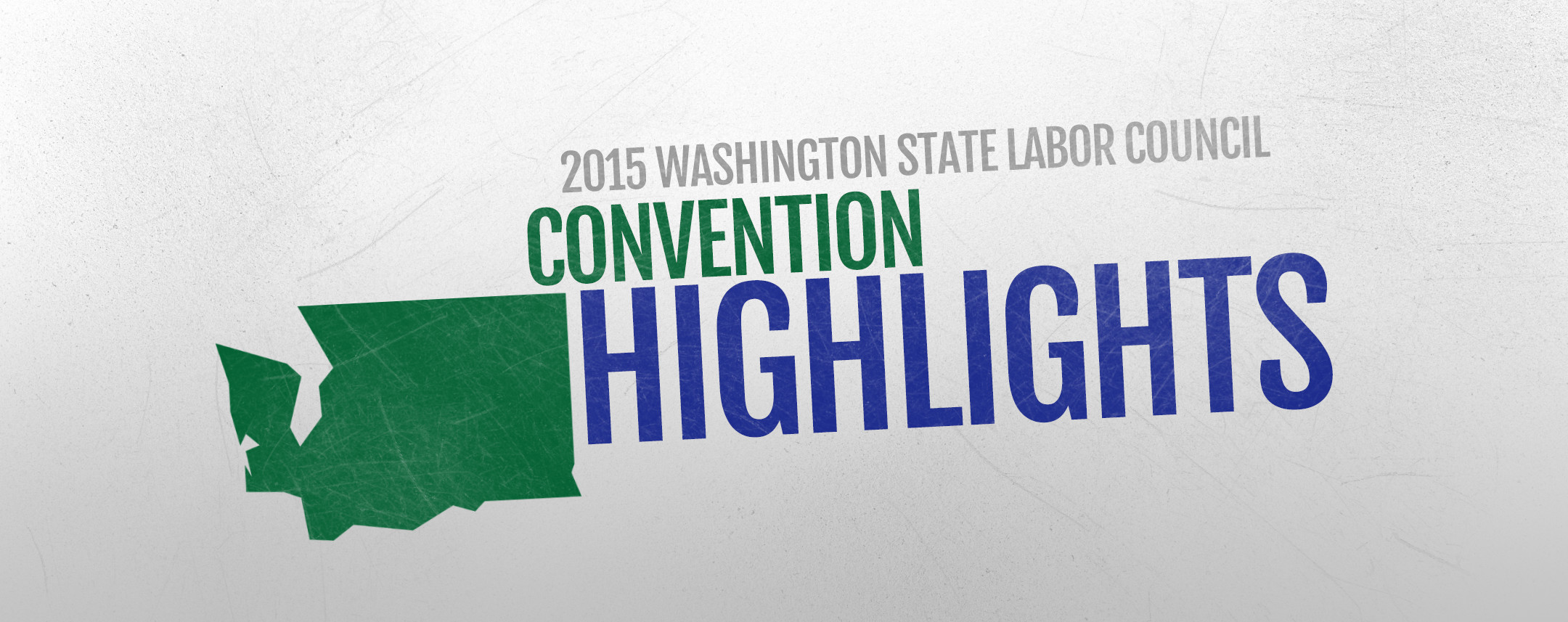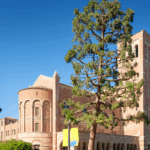Last weekend, in SeaTac, Wash. — the birthplace of the $15 minimum wage — delegates from labor unions across the state gathered at the Washington State Labor Council (WSLC), AFL-CIO’s 2015 constitutional convention to discuss the ambitious goals of saving the economy and the planet by fighting inequality.
Unfortunately, it is impossible to catalogue and respond to everything that was said by the assortment of leftist speakers that headlined the event, but some of the more interesting excerpts and highlights are provided below.
- Tefere Gebre, AFL-CIO International executive vice president
- Gebre: Does mass incarceration actually contribute to this inequality? Yes it does.
Audience member (probably Department of Corrections employee): No!
Gebre: Let me finish. When we do a national survey of workers in this country, eight out of 10 African-Americans tell us they would join a union if they get an opportunity. Here’s a problem: Most of those people are locked in jail or, when they come out of jail, because of a record, they can’t join a union. They can’t help you raise wages. That’s why fighting mass incarceration has to be part of our raising wages agenda.Gebre’s statement is so absurd it’s difficult to tell if he is serious. He seems to plainly argue that most black workers would join unions if only they weren’t in prison and, consequently, reducing the number of incarcerated African-Americans would raise wages as they all join unions.
For starters, according to the U.S. Department of Justice, only about 3 percent of black males in America are incarcerated, and the rate is less for black women. While the incarceration rate for blacks is notably higher than other races, Gebre’s assumption that “most” black workers are incarcerated seems more than a little racist.
From an economic perspective, introducing more workers into the labor force—white black or otherwise—seems like it would drive wages down, not up.
Lastly, one wonders how unions representing corrections employees would respond to Gebre’s message. There are indeed many facets of the criminal justice system worth examining for reform, but unions representing corrections workers, like the notorious California Correctional Peace Officers Association, have been some of the staunchest advocates for the kinds of tough-on-crime policies that increase the prison population and contribute to the problem of “mass incarceration.”
- We will be kidding ourselves if we think we can raise our wages when 11 million hard-working people in this country, 11 million people, are working in the shadows and being taken advantage of and pulling everybody’s wages down. See, when we get real immigration reform, we will get 11 million brothers and sisters who will stand up and fight for the same values that you care about and march on the streets with us. That’s why immigration reform has to be a key part of our raising wages agenda.
Immigration is a touchy subject for unions. The traditional position has been that immigrants will undercut wages and constitute low-wage competition for union trades. But unions have long abandoned that conventional wisdom. Gebre’s comments seem to indicate that the AFL-CIO’s view is that providing legal status for the 11 million people who have emigrated illegally would enable them to more fully participate in the labor movement as activists and dues-payers. - Audience member: What is the AFL-CIO, at the national level, looking at for legislative action possibly, if the (U.S. Supreme) Court decision (in Friedrichs v. California Teachers Association) swings toward the opposite side, to allow lots of employees to opt out of their unions? Specifically, is AFL-CIO looking at legislation to attack the free rider?
Gebre: Yes, we are. We always are.
While short on specifics, Gebre appears to confirm that the AFL-CIO would seek national legislation potentially banning right-to-work laws at the state level. Such laws prohibit unions from having workers fired for refusing to pay dues. Former Labor Department head and arch-progressive Robert Reich recently called for such legislation, and the National Labor Relations Board recently announced it was considering a rule change that could roll back state right-to-work laws. - Germany has 70 percent union density. Germany is a right-to-work country, as a nation, it is a right-to-work country. So, no law is going to substitute for our own organizing ability.
While decrying right-to-work laws on one hand, Gebre also argued that unions would be just fine in a nationwide right-to-work environment as long as they focused on internally organizing their members. Similar rhetoric was heard repeatedly at the convention.
- Gebre: Does mass incarceration actually contribute to this inequality? Yes it does.
- Saru Jayaraman, co-director of the Restaurant Opportunities Center United and director of the Food Labor Research Center at U.C. Berkeley
When I talk about the restaurant industry, I’m talking about everything from McDonald’s all the way up to the fine dining steak house. And our research shows that poverty wages exist across the entire industry. And six out of the seven lowest-paying jobs in America are full-service restaurant jobs, restaurants we all eat in every day of our lives. And all of our research shows — how is it that you’ve got one of the largest and fastest-growing and, in our research, most profitable industries in America proliferating the absolute lowest paying jobs in the country? It is all due to the money, power and influence of a trade lobby called the National Restaurant Association. We call them ‘the other NRA.’ And they actually kill more people, statistically, than guns do, not that guns are great, right? But they do kill more people.
As a labor activist in the food service industry, Jayaraman regularly employs fiery rhetoric against restaurants, but the claim that “the other NRA” kills more people than guns each year is both novel and highly unlikely. Perhaps some creative documentation for Jayaraman’s claim exists, but it does not appear to be readily available on the Restaurant Opportunities Center website. - Jeff Johnson, president of the Washington State Labor Council
- Far too many workers still don’t have jobs. While our official state unemployment rate has been falling — it’s about 5 and a half percent right now — our actual unemployment rate is more like 12 percent when you take into account those workers who have given up looking for work and those who are involuntarily underemployed. When you look at unemployment by race, we find black and Latino workers with much higher unemployment rates than the rest of the population. At the height of the Great Recession in 2010, our overall unemployment rate was 10 percent in this state, but for Latinos it stood at 15.8 percent and for blacks it stood at 21.1 percent in the state of Washington… These disparities are a combination of occupational segregation, institutional racism, and the lack of access to job training and employment opportunities. (Emphasis added)
Fair enough. But what is Johnson’s proposed solution to the problems of the Obama/Inslee economy? Make it harder for low-skilled and less-educated individuals to find work.
- We have to recognize that many of our lowest-paying jobs are overrepresented by women and workers of color… Raising the minimum wage to at least $12 an hour in Washington state would raise wages for over a half million workers and would provide $1 billion of purchasing power to our communities and would lower our state’s poverty rate. An increase like this would especially hurt, help workers of color and women who work in low-wage industries.
The WSLC made similar claims and promises back in 1998 to get voters to approve Washington’s current minimum wage law, the highest state minimum wage in the nation. What happened? The poverty rate didn’t budge, job growth in low-wage/entry-level industries slowed and the unemployment rate for low-skilled workers like teens skyrocketed. - And then we have a panel on how we talk to our own members about right-to-work-for-less, and that’s in Evergreen Four. And I want to remind the sergeant-of-arms that, for that particular workshop, be standing by the door and checking credentials.
Apparently the WSLC doesn’t want to leak the top secret reasons why employees might want to keep paying union dues if they no longer have to. Odds are, if the reasons are so secret, most public employees will have no idea what they are, which doesn’t bode well for the WSLC. Video clip available here.
- Far too many workers still don’t have jobs. While our official state unemployment rate has been falling — it’s about 5 and a half percent right now — our actual unemployment rate is more like 12 percent when you take into account those workers who have given up looking for work and those who are involuntarily underemployed. When you look at unemployment by race, we find black and Latino workers with much higher unemployment rates than the rest of the population. At the height of the Great Recession in 2010, our overall unemployment rate was 10 percent in this state, but for Latinos it stood at 15.8 percent and for blacks it stood at 21.1 percent in the state of Washington… These disparities are a combination of occupational segregation, institutional racism, and the lack of access to job training and employment opportunities. (Emphasis added)
- Liz Atkinson-Pattinson, Olympia Olive Garden employee, college student and Working Washington activist
In my workplace, we started just by talking to everyone. There were a few of us who were really interested in 15 and paid sick and safe leave, and it was essential that we were able to get together in a safe space to meet and talk to everyone that we could. So we started setting up meetings every Thursday evening to talk about our issues and start planning and strategizing for taking action. So out of that, we decided to go on strike, which was one of the most powerful experiences of my life, like, I could cry just thinking about it. So we went on strike twice and what came from that was incredible media attention and, you know, community members and other workers coming and asking us questions — what are we about, how can they join. And since then the numbers have continued to grow in Olympia, and we have a really strong base there. We’ve also marched through downtown, through the mall to really let people know what our campaign is about, get the word out. And we have had lobby day with the Senate, we go to city council meetings, and what’s been the most essential piece is having support. We’ve had AFSCME (American Federation of State County and Municipal Employees) and UFCW (United Food and Commercial Workers) at all of our actions, which has been incredible — thank you — and fast-food workers from all over the place — Tacoma, Kent, Federal Way, Seattle — and we go and support them when they take action. What is coming up for us: We take action in three ways every single week. We go to the city council, we testify, we have new workers come and speak every week. Our Thursday meetings are continuing and we’re also door-knocking and petitioning on the weekends to get community support to hand that into city council and demand that they make these changes. We are also going to have a community day, a low-wage-worker town hall in the beginning of fall where we’re going to have city council up there, ask them questions, and really do community outreach and let our Olympia community know what we’re up to. And continue to take action.
So unions are driving the minimum wage push, SEIU-funded Working Washington is busing the same college protestors to locations around the state and making their numbers appear larger than they really are, and activists are targeting Olympia for their next job-killing $15 minimum wage campaign. All in all, no big surprises. - Dow Constantine, King County Executive
Where workers have more money (because of increases in the minimum wage), businesses have more customers. And when businesses have more customers, they can hire more workers. I plan for this to be the subject of my doctoral dissertation some day. It’s a very complex and novel theory (sarcasm). It’s a virtuous cycle.
Constantine sounds like he’s channeling his pal, progressive millionaire Nick Hanauer. Nice theory but, unfortunately, it’s entirely inaccurate. The money to pay employees a higher minimum wage comes from employers, who typically have to increase prices or scale back on labor to pay for it. No matter how you slice it, it is impossible to argue that arbitrarily increasing a firm’s labor costs is going to be good for the firm or the economy generally in the long run. - Greg Devereux, Executive Director of the Washington Federation of State Employees
- When we look out on the horizon, though, there is a U.S. Supreme Court decision lurking (Friedrichs v. California Teachers Association) that could decimate the labor movement in general, and many unions like ours in particular… Many, many predict — and I’d say most of the AFL-CIO in-house counsels predict — that the current court will, at a minimum, rule that nonmembers covered by our contracts — what have been referred to as ‘fee-payers’ or ‘free-riders,’ will no longer have to pay a fee for our representation services. What that means for my union is 6,000 people no longer have to pay a fee; we still have to represent them. The court also may say that membership in public-sector unions is merely voluntary. In that scenario, members who are fence-sitters might choose to drop their membership. Worst-case, the court could rule that we, public-sector unions, cannot bargain over any matters of public concern, essentially neutering public-sector unions by eliminating economic bargaining. None of these outcomes look promising for the public-sector unions and, on the surface, Friedrichs looks like only a public-union disaster. It certainly is that, but it is potentially much more than that… Friedrichs really is a movement problem, not just a public-sector problem.
Despite pessimism from conservatives about the likelihood of the Supreme Court making the right decision in Friedrichs, it appears that public-sector unions are taking the threat quite seriously.But all is not lost, according to Devereux, who argued, “It is far more productive to see Friedrichs as an opportunity.”
- For the first 24 years of my union’s existence, we survived without any collective bargaining law. We relied only on contract law. The members soldiered on, and they kept building a union. In 1967, limited collective bargaining finally passed the legislature. That law allowed bargaining over working conditions only, not over economics. For the next 36 years, our members kept building a stronger union, even without economic bargaining. So for over 60 years, my membership created an effective organization through persistence and guile, not through legislative protections… In 2002, after sixteen years of effort, we passed full-scope collective bargaining, and many of you have witnessed firsthand the changes. As I mentioned, we doubled in size. I outline this short history lesson so you can see my union, like probably most of yours, have always been scrappy underdogs. We were born in tough times, we’ve been quite successful for decades without legislative underpinnings. We’ve learned over time not only to survive but to thrive despite the odds. Today is no different.
So, on the one hand, government unions are going to be “decimated” by right-to-work and, on the other hand, the “scrappy little (multimillion dollar) underdogs” are going to be just fine. But what else could Devereux say to a roomful of union officials? The same tension in messaging exists in unions’ communications with their members. Unions must walk a fine line between messaging their achievements, without which there would be no point in belonging to the union, and the imminent threat posed to those achievements by evil management/billionaires/politicians/think tanks, without which there would also be no point to remaining in the union. - Friedrichs may force chance that we’ve needed for a long time, but I don’t think that’s a bad thing necessarily. The wolf may come knocking at the door soon, but my message to all of us is simple: All of us, private and public-sector leaders, need to prepare our members for the onslaught.
- The members need to see us physically in their workplaces. We need to have one-on-one conversations with our members. Yes, it is labor-intensive. How do you go talk to 40,000 state workers? It is labor-intensive. But that’s why we have activists and stewards… We need to internally organize in a way we never have before. If members see us in their workplaces solving problems, if we teach them to solve problems in their own workplaces, they will understand the value of the union.
Translation: WFSE might have to actually start acting like a union. - We are in one hell of a potential struggle. We need to be in combat mode, we cannot afford to waste time… With Friedrichs on the horizon, I say, ‘Damn the torpedoes, full speed ahead!
Indeed.
- When we look out on the horizon, though, there is a U.S. Supreme Court decision lurking (Friedrichs v. California Teachers Association) that could decimate the labor movement in general, and many unions like ours in particular… Many, many predict — and I’d say most of the AFL-CIO in-house counsels predict — that the current court will, at a minimum, rule that nonmembers covered by our contracts — what have been referred to as ‘fee-payers’ or ‘free-riders,’ will no longer have to pay a fee for our representation services. What that means for my union is 6,000 people no longer have to pay a fee; we still have to represent them. The court also may say that membership in public-sector unions is merely voluntary. In that scenario, members who are fence-sitters might choose to drop their membership. Worst-case, the court could rule that we, public-sector unions, cannot bargain over any matters of public concern, essentially neutering public-sector unions by eliminating economic bargaining. None of these outcomes look promising for the public-sector unions and, on the surface, Friedrichs looks like only a public-union disaster. It certainly is that, but it is potentially much more than that… Friedrichs really is a movement problem, not just a public-sector problem.








